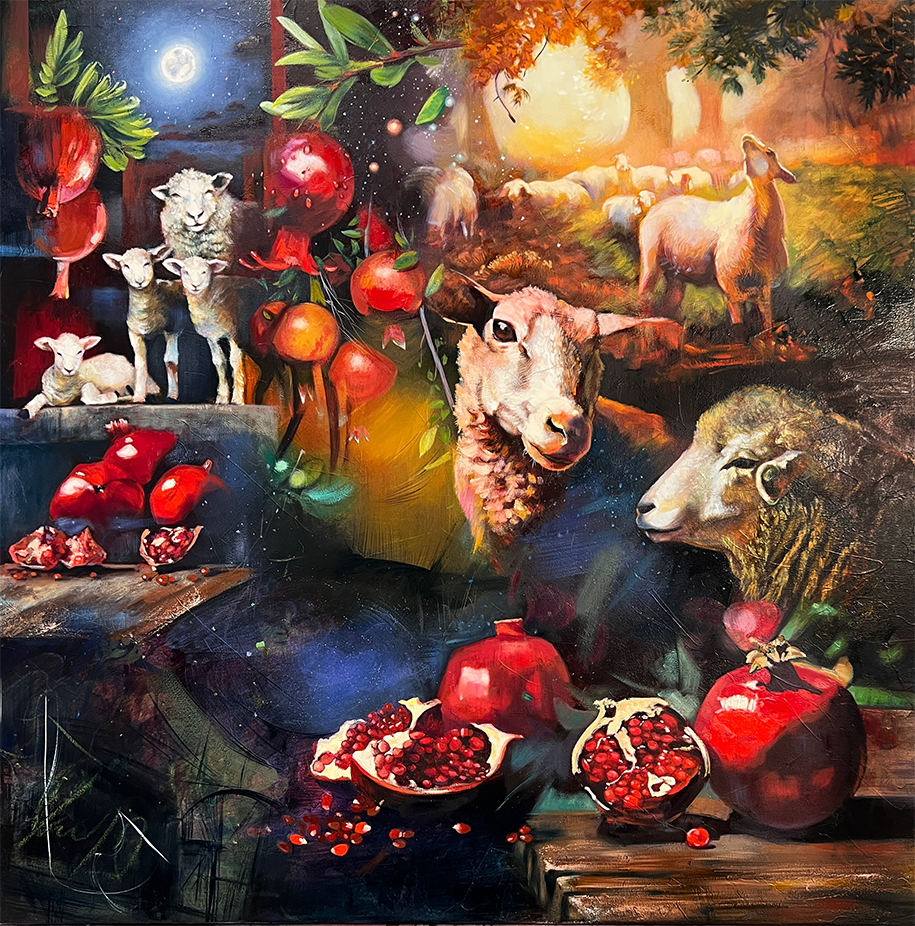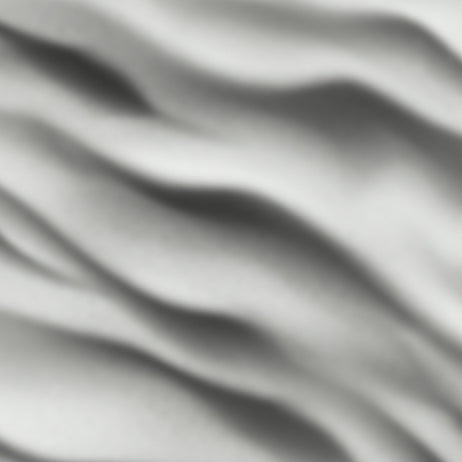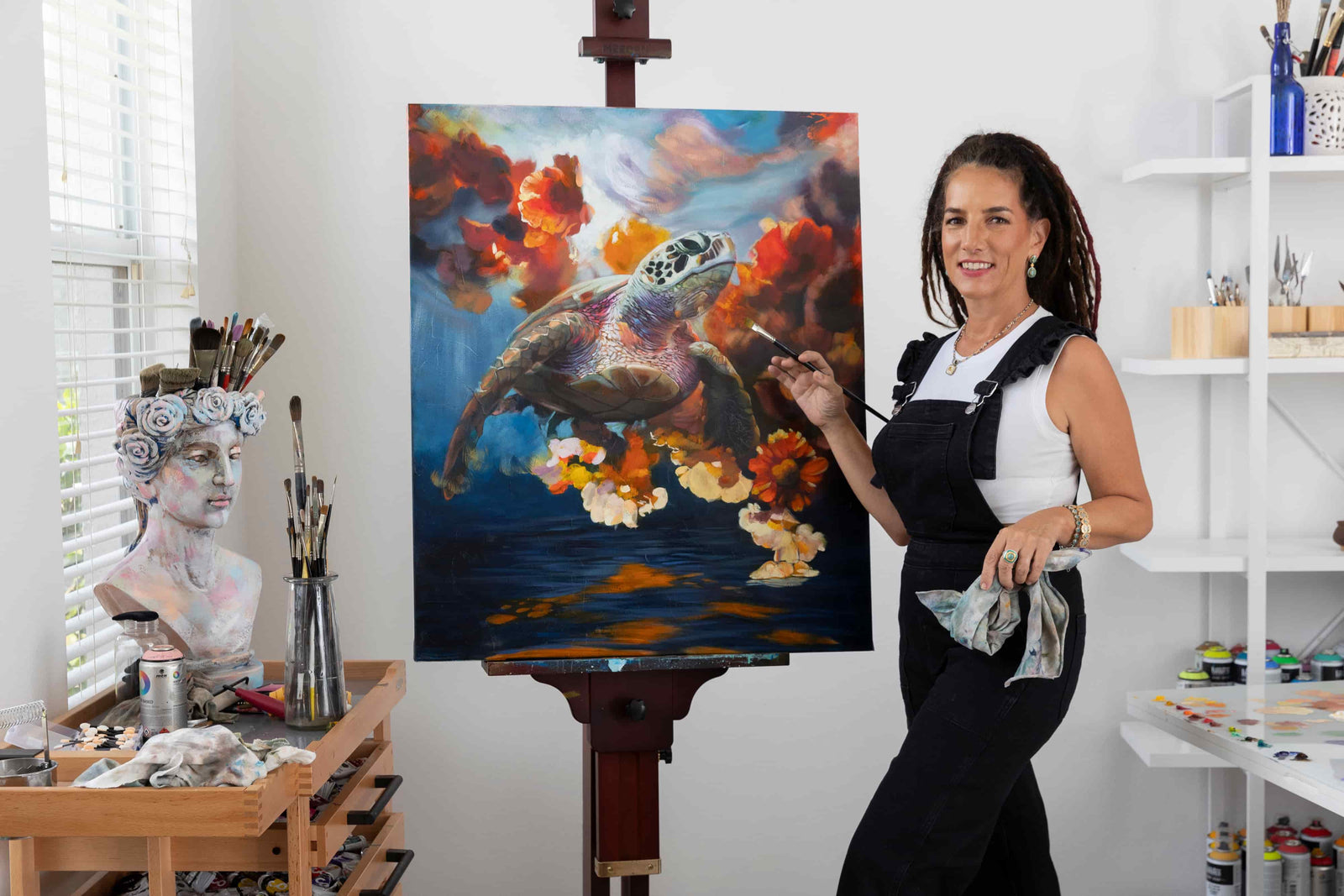Snakes, Sources, and Creative Limitations: An Important Truth for Artists of Every Age

It’s 1992 and blazing hot, and we make a quick stop to pick up a video to watch later. We just stopped at the pet store to grab a couple of mice for our pet ball python. The mice come in a mini cardboard box with breathing holes on the side.
We only stay inside Blockbuster for a few minutes, but when I come back out, they’ve eaten through the box and are loose in the car. I feel terrible for giving these poor little mice such an awful life just before they become dinner for our pet snake.
We sit in the car with the AC barely running, remaining very quiet to hear where the rustling might be so we can find the mice. My imagination starts to go off, and I am thinking about mice chewing through floor boards, wires, and brake lines, leaving trails of poop and pee everywhere. Why didn't we just bring the little box inside with us?! Now what?
With no sign of the little critters, John decides to get out and move his seat around, making a lot of noise to scare them out of hiding. Finally, we start to see little white mice blur through the car, scurrying into the back seat, back under the driver’s seat, and up through the emergency brake area.
I grab one! It wiggles in my hands as I make him a little mouse house by cupping my hands, hoping and praying he won't bite me. I can feel his little claws in my hands. John grabs the box, and I throw him inside, closing the lid and covering the chew holes with my hand.
One caught and one more to find.
Now I am over my little fright of the mice and have braved handling one of them. My fears of either getting bit or squishing it didn't materialize, so I’m searching for the second mouse with more confidence.
We try the same tactic with the second mouse. I shift my seat back farther, making noise and hoping he isn't caught in the rails of the chair sliding. Finally, after some ruckus, the mouse starts running around and makes his way up onto the dashboard.
John has quick hands and catches him. I open the lid, and John throws him in with his friend. Lid back on and holes covered. Now we can breathe! That was close. John and I agree to never do that again, and if we make a pit stop next week to bring the mice with us.
The Strange Cost of Inspiration

Every week when our ball python needed to eat, he would get two small live mice. He would only eat live mice and not frozen or dead ones, so we had to participate in the this very necessary but gruesome ritual. The feeding took place in our empty bathtub, where neither the mice nor the snake could get out.
I found it fascinating but also sad and terrible. The mice didn't seem to suffer, and while one was caught, the other just milled around, seemingly unaware. I didn't really enjoy watching the whole thing.
The snake would lie semi-coiled up, waiting until the mice walked right by him. In an instant, the snake would the mouse, hugging him tightly until he passed out and then died through the constriction. Once the mouse was dead, the snake slowly positioned himself and proceeded to swallow the mouse whole.
You could see the lump of the mouse move down through the snake’s body. We usually just dumped the mice inside the tub and walked away, leaving them to it for the rest of the afternoon until we came back to a mouse-free tub and a satisfied, docile python.
Our ball python was medium size, about 2-3 feet, beautiful in pattern and color, and very docile. He moved very slowly and didn't seem to mind being held. Sometimes he was very active and would roam around the apartment exploring, moving up and down the furniture. I think I thought it was kind of cool to have a snake. Like an edgy artist thing to do when you’re in art school.
An Unexpected Muse

The reason I got him is our neighbor who was also an art student, wanted my keyboard to play music. None of us had money, so he offered to trade the snake and his habitat for my keyboard. We hardly used the keyboard, and I thought having a snake could make for a series of interesting paintings.
The sources I used were exclusively my own photos that I took, usually with my old Polaroid I got when I was a kid. I liked the Polaroid because I could see right away what kind of picture I had and didn't have to wait until the film was developed. I also had a regular film camera, but it only worked with a flash and washed everything out. The flash feature on the Polaroid was manual, and if you held real still or set the camera on a table, you could get good lighting not using the flash.
I was always subjecting John and my friends to some kind of photoshoot involving weird scenes and narratives that I hardly even knew the meaning of. But if it looked like it could have a meaning, then it was worthy of painting in my book. I figured the viewer could make up their own story.
Sometimes I had a plan and knew what I was trying to say, but mostly it was setting up a scene that provoked questions. I played with Christmas lights for interesting light effects. Our sweet little calm snake took part in many photoshoots and was fun to paint.
A Python and a Polaroid

Creating sources was so different before digital cameras and the internet. We either took our own photos, which cost a fortune, or we went to the library. But I always forgot to return the books on time and would get fines. I went to Kinko’s to get color Xerox copies of the pictures in the library books, but it was almost as expensive as getting film developed. I bought magazines at thrift stores and combed through them looking for anything I could paint or incorporate into my paintings.
My professor at SCAD showed us how to take photos with a Minolta and a tripod in low light. Having a Minolta was the ultimate at that time to be able to create amazing source photos using a window for light, a few props, and some friends. He showed us how to position people, angles to take the photos, and how to create narratives that looked like a still from a movie, where you knew something was going on, but you weren’t sure what. He showed us how to leave a long exposure to capture all of the highlights and shadows for a moody effect.
I wanted to upgrade my Polaroid for a Minolta, but they cost a lot. Then there were lenses and a tripod. It was all out of my budget for now. I had to make do with my point-and-shoot and Polaroid.
I felt grateful to have photography and magazines to utilize when the artists before us had to set up scenes with live models and pay a fortune for them to pose. They had to work from studies and sketches and paintings, and handcrafts were the only images the people back then saw outside of real life. No TVs, photography, or billboards. Each artist’s own inspiration existed outside of images in some other form.
Monet found inspiration while contemplating near a lily pond. Van Gogh found inspiration walking through the fields among the haystacks. Toulouse-Lautrec and Degas sketched at the ballet and theater. I traded a keyboard for a pet snake to inspire my storytelling and suffered through the brutality of a weekly feeding to get those precious pictures.
More Than a Meal

We are home from the pet shop and video store with mice in tow. I dump them into the bathtub and go to the glass-enclosed habitat to grab the snake for his weekly sustenance. He sits there waiting for me, extending his forked tongue to smell who is coming.
I reach out my hand to grab him as usual, thumb separate from fingers, ready to grasp, when in an instant he lurches toward my hand and bites down between my thumb and first finger. Without thinking, I jerk my hand out, lifting the python who is attached to my hand by his jaws and needle teeth.
In a complete panic, as if I am about to die, I shake my arm to get him loose, screaming like I’m being murdered. He sadly sails across the room, shaking loose from my mad flinging, hitting the wall, and slamming on the ground.
John comes running, and I grip my hand crying.
I tell John, “He bit me, he bit me! He was crushing my hand, so I tried to shake him loose, and he hit the wall and fell. He might be injured!”
I’m crushed and feel so bad that I might have hurt him. I just reacted and couldn't think clearly. A python bit my hand and was trying to coil himself around my wrist. I was told if that ever happened you calmly just grab the tail and uncoil, and they will realize you are not food and let go. But I couldn't think. I just panicked.
John goes to the wall where I threw him and says, “He might be okay. He is just sitting here. His tongue is still moving. He looks normal.”
I look down at my hand and see it has a super puffy red oval shape with tiny holes. There’s no blood, but it hurts. I can't believe how hard he clamped down and how strong his grip around my wrist was.
“John, don't pick him up! You have mice smell on your hands too. I think he thought I was a mouse because I had their smell on me. Get a towel or something to pick him up.”
John grabs him through the towel and carefully carries him to the bathtub where we will find out if he is still able to move and eat. The second he lays him down, he quickly springs into action and goes after one of the mice. Without the slightest indication of injury, the snake snatches the mouse, turns into a ball, and begins suffocating it to death.
“I guess he was really hungry,” I say.
“Yeah. He seems okay. I don't think he is hurt,” John says, relieved.
The Artist's Calling

After that, I was terrified of the snake. I left him inside his glass enclosure and didn't want to touch him again. It wasn't his fault, but I didn't ever want to experience that again. I had thoughts of him getting out of his glass box, coming for me while I was sleeping, and finding my neck.
Within a few days, I returned him to the neighbor who gave him to us to start with. He had sold the keyboard by this time, so there was no trade. But I was snake-free and done with that as a painting subject.
I knew to become the artist I wanted to be, I had to get that Minolta camera I dreamed of and take photos how my professors showed us. My days of snakes and Polaroids were over, and now I wanted to move on. I wanted to capture light and the effects of light. I wanted to create mood and drama and knew the only way was to save up for the camera.
Source making for an artist always takes time and dedication and some kind of process that is almost as unique as the process of creating the art itself. The tools we have are the boundaries we deal with in our creative process. As the years pass, we have more and more access to more and more tools.
Now you can type into an AI app what you imagine painting, and it will spit out a realistic photo of whatever you said. I never could have conceived of this tool when I was in art school. My professors could never have seen it coming. We create with what we have in the time we live in. The innovations we are blessed with determine the boundaries of our creativity.
I can't even imagine what Da Vinci would think if he saw the projectors, internet, AI tools, Photoshop, cameras, and computers. What would he have created? How would Caravaggio or Artemisia have handled their creativity with all of these tools? What if Van Gogh had a computer and spray paint?
What a responsibility we have. As artists, we must still create. We must reach deeply into the ether and pull from it the wispy messages from a realm beyond, forming them by brushstrokes into an imagery that speaks poetically. A painting that brings the far things near. We can't just drop a line into Midjourney and paint whatever the robot spits out. As artists, we can't just mimic the hollow energies of computers.
With all of these choices and tools, living in a world saturated with images from our phones, Pinterest, Instagram, and YouTube, we have to ascend higher, far above the ordinary we compete with, and produce something wholly human and—yes—wholly divine. We have no choice but to aim, reach for, and contend for sublime beauty, for what is wondrous and fascinating, what is utterly otherworldly, and bring it forth. We are ambassadors between two worlds.
This cannot be done alone. It is done as a movement, as a collective. This high calling is achieved only with help from God.
What’s the most unconventional source of inspiration you’ve ever used in your creative process?







Hi Elli, The story of trading the keyboard for the snake… Never! But sure made a good story. But, more seriously, the paintings I’ve painted were mostly inspired by the the atmosphere created by worship and prayer. Until I took the Mastery Course of which I am finally nearing completion, I had not really used sources much except for structure or perspective. I now create ideas boards for ideas I want to combine. Finding out that I’m high I with more S than D gave me a sense of understanding of why I like that impulsive, eclectic approach. I so appreciate MAI and look forward to completing the program.
———
Elli Milan Art replied:
Yes. It’s true. Sources to follow are for the D C who really like a plan.
Not sure I have an answer to your question, but what stayed with me most was how you turned an unexpected, messy experience into a reminder that our limits often shape our creativity more than the perfect tools ever could. Your contrast between the old Polaroid days and today’s endless digital options hit home — but even more so, your call to protect that irreplaceable human–divine spark. This is exactly why we create: to pull something unseen into the light and offer it to the world. Thank you, Elli for the story, the smile, and the nudge to keep reaching higher. 🙏🥰
———
Elli Milan Art replied:
Hi Chris. I’m fascinated by what will come of this. What world we are shaping through this creative boon we are in. 🙌🏽😊
Leave a comment